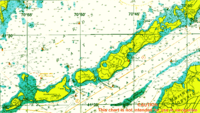Penikese Island
| The Elizabeth Islands |
|---|
 |
| Major Islands listed in order from east to west |
| Nonamesset Uncatena Naushon Pasque Nashawena Penikese Cuttyhunk |
| Minor Islands: |
| Bachelor Baret Bull Cedar Gosnold Gull Rock Veckatimest Weepecket Islands |
Penikese Island is a 75-acre (300,000 m2) island off the coast of Massachusetts, United States, in Buzzards Bay. It is one of the Elizabeth Islands, which make up the town of Gosnold, Massachusetts. Penikese is located near the west end of the Elizabeth island chain.
History
Penikese Island enters the historical record in 1602 AD when the English explorer Bartholomew Gosnold and some of his crew visited the island. Their visit frightened four visiting Wampanoag Indians into hiding, and the explorers stole their canoe.[1]
Originally tree covered, at some later time the tree cover was lost, and the island was later used for pasturing sheep.[2] To this day, it remains primarily grass covered.[3] Owned by several successive owners, it eventually became owned by a businessman named John Anderson who used it for vacationing.[4]
In early 1873, Louis Agassiz, the famous Swiss-American naturalist, persuaded Anderson to give him the island and $50,000 to endow a school for natural history where students would study nature instead of books. The school opened in July 1873, initially headed by Louis Agassiz. Following his death in December, his son Alexander Agassiz ran the school. The school was closed following a fire in 1875, but some of the former students opened in 1888 the Marine Biological Laboratory, in nearby Woods Hole.[4][5][6]

In 1904, following local opposition to two previously selected sites on the mainland, the state of Massachusetts purchased the island for $25,000 to use as a leprosy hospital to isolate and treat all Massachusetts residents with the disease. When opened, it had five patients. After being open for 16 years, it was closed in 1921 and the thirteen patients were transferred to the federal leprosy hospital in Carville, Louisiana. At the closing of the hospital, the state burnt and then dynamited the buildings, and all that remains of it is a small cemetery.[7]
The island remains under the ownership of the Commonwealth of Massachusetts and is primarily a bird sanctuary. There is no permanent population on the island. A residential school for special-needs juvenile boys located on the island, opened in 1973, so at any time there could be found school staff and some students on the island.[4] There may also be visitors and researchers on island from time to time, as the island is publicly owned and is still used at times for biological research.[8][3] Beginning in 1990, the island was used as a test site for efforts to reintroduce the endangered American Burying Beetle, which appears to have succeeded; by 1997 the population had persisted for at least five generations since the last release.[9]
Penikese Island School
Penikese Island School operates a substance abuse treatment program for young men recovering from opiate or alcohol addiction. From 1973 to 2011 the program was a private residential school for troubled boys. The school was alternative to juvenile detention, and earned a reputation for its intimate size, quaint setting, and “choice and natural consequences” philosophy, attracting media attention and countless documentaries about the program. The school's mission served teenage boys who had not recovered with more traditional programs.
Penikese Island Long-Term Treatment Center.
In the fall of 2015, a long-term opioid-addiction treatment facility named Penikese began operation on the island.[10]
References
- ↑ Schneider, Paul (2001). The Enduring Shore: A History of Cape Cod, Martha's Vineyard, and Nantucket (illustrated ed.). New York: Macmillan. p. 12. ISBN 0-8050-6734-5. Retrieved 18 March 2009.
- ↑ Jordan, D. S. (April 1874). "The Flora of Penikese Island". The American Naturalist, an Illustrated Magazine of Natural History. Salem, Mass.: Peabody Academy of Science. VIII: 13 (193). Retrieved 18 March 2009.
- 1 2 Laux, E. Vernon (23 May 2000). "Is It a Plane? No, It's a Bird And a Very Rare Bird Indeed". The New York Times. Retrieved 18 March 2009.
- 1 2 3 "History: Penikese Island History: The Anderson School". Penikese Island School. Retrieved 19 October 2012.
- ↑ "The Anderson School: Opening of the Establishment on Penikese Island by Prof. Agassiz" (PDF). The New York Times. 19 July 1873. Retrieved 18 March 2009.
- ↑ Lattin, Frank H. (1895). Penikese: A Reminiscence by one of its Pupils. Albion, N.Y.: Frank Lattin. p. 43. Retrieved 18 March 2009.
- ↑ Ken, Hartnett (26 November 2005). "The tragedy of Penikese Island". The Boston Globe. Retrieved 18 March 2009.
- ↑ "General FAQ". Penikese Island School. Archived from the original on February 8, 2009. Retrieved 18 March 2009.
- ↑ Reading, Richard P.; Miller, Brian (2000). Endangered Animals: a Reference Guide to Conflicting Issues (illustrated ed.). Westport, Conn.: Greenwood Publishing Group. p. 15. ISBN 0-313-30816-0. Retrieved 18 March 2009.
- ↑ Karen Brown (November 21, 2016). "Treatment Island: Addicts Are Sent To Recover Off The Coast of Cape Cod". NEPR.net. Retrieved November 21, 2016.
External links
- The Penikese Island School website
- Cuttyhunk Historical Society, the Museum of the Elizabeth Islands
Coordinates: 41°27′04.45″N 70°55′20.87″W / 41.4512361°N 70.9224639°W